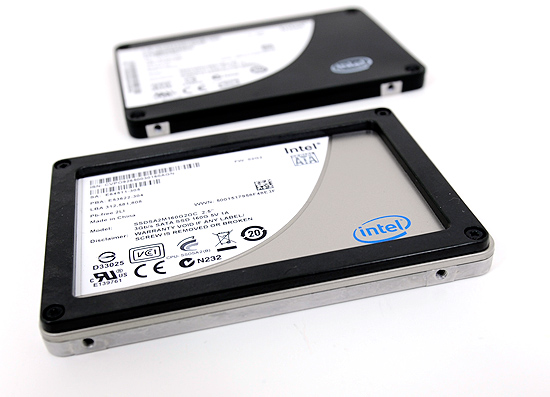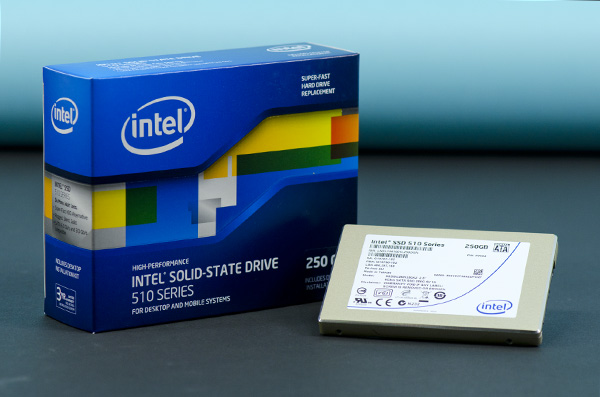The Intel SSD 510 Review
by Anand Lal Shimpi on March 2, 2011 1:23 AM EST- Posted in
- IT Computing
- Storage
- SSDs
- Intel
- Intel SSD 510
The X25-M was a tremendous first attempt by Intel to get into the SSD market. In our review of the SSD I wrote that Intel just Conroe’d the SSD market, and if it weren’t for the pesky 80MB/s sequential write speed limitation the X25-M would’ve been given the title: World’s Fastest Drive.

Its successor, the X25-M G2, was a mild update that brought prices down through the use of 34nm NAND. Remember that Intel is also 49% owner of the IMFT joint venture and as a result can be quite competitive on NAND pricing (and quite early to adopt new NAND technologies).

Intel’s goal all along was to drive down the cost of SSDs. Looking at the history of MSRPs with the X25-M (not to mention the M, which stood for Mainstream in the product name) this shouldn’t come as a surprise:
| Intel X25-M Pricing History | |||||
| 2008 | 2009 | ||||
| 40GB | - | $125 | |||
| 80GB | $595 | $225 | |||
| 160GB | $1000+ | $440 | |||
The third generation X25-M was to drive down costs even further, this time thanks to Intel’s 25nm NAND. You’d be able to get twice the capacity at the same price point as the X25-M G2. The value drive would be an 80GB offering, the mainstream drive would be 160GB and the high end drive would be 320GB.
The drive would offer higher performance. The controller was to be completely redesigned, with the “oversight” that limited sequential write speed to only 100MB/s corrected entirely. In addition, the third generation Intel SSD would add full disk encryption - making it even better suited for enterprise customers. Going after the enterprise market was Intel’s plan to really make money on SSDs in the long run. Instead of just selling corporations a CPU, chipset and wireless controller in a notebook, there would be an SSD on top of all of that. Perhaps eventually even have some security software courtesy of McAfee.
The third generation X25-M was originally due out in the middle of 2010. As is usually the case with schedules, the “G3” slipped. The middle of the year became the end of the year and the end of the year became Q1 2011.
To make matters worse, the specifications Intel was talking about for its third generation drive/controller weren’t all that competitive. We published the details last year knowing that the competition would do better. Intel’s redesigned controller was late and underperforming. Internally, Intel knew it had a problem.
Intel aimed for the majority of the market with the X25-M, it had set its sights on lowering cost, but it left the high performance enthusiast market entirely uncared for. A void that SandForce filled quite nicely with its unique brand of controllers.
With a hole in the roadmap and an unwillingness to cede complete control of the high end market to SandForce, Intel did the unthinkable: developed a new SSD based on a competing controller technology.











128 Comments
View All Comments
lyeoh - Wednesday, March 2, 2011 - link
Oh yeah, thanks for the max latency figures. They're very useful.The G2's max of 900ms is quite a long time. Nearly a second! What are the max latencies for say a velociraptor in similar tests? I know the theoretical figures would be based on seek time + RPM but often theory is different from practice.
I find it interesting that the Crucial RealSSD C300 does worse than the Intel SSD 510 in the "Anand Storage Bench 2011- Heavy Workload" despite getting better numbers in the random and sequential tests. Any idea why this would be so? Poorer max latency?
jimhsu - Wednesday, March 2, 2011 - link
Poorer sequential performance I guess. The C300 (which I just got) is very fast, but the sequential perf of the 510 is simply better, which impacts a lot of the sequential portion of the workload test. Random performance in typical desktop models has reached somewhat of a plateau, particularly since most applications currently out there are optimized for the dog-slow random performance of consumer hard drives.Creepwood - Friday, March 4, 2011 - link
About reliability/compatibility: have you tested this drive in the new Sandy Bridge Macbook Pro? Any issues?davepermen - Monday, March 7, 2011 - link
Interestingly, one of THE main performance cases is when you need to quickly write lots of stuff, like in video editing. And there, all data is at least partially compressed, so i guess there the intel will be in a better place.RaistlinZ - Wednesday, March 2, 2011 - link
Intel is going to have to price this thing cheaper than the Vertex 3, or any other new Sandforce SSD for that matter. They can't use performance as a selling point. I'm sure the new SF controller will offer good stability. Unless you're an Intel fanboy I don't see any reason to get the 510 over the Vertex 3, unless they price it much lower.semo - Wednesday, March 2, 2011 - link
This is an Atom alright!I think the conclusion, although critical in places was overall mild. “It looks like we may have hit the upper limit of what we need from 4KB random write performance”… Yeah, in the consumer/budget space. But what consumer/budget computer user would buy a 250GB SSD. I’ve managed to convince a few of my clients to go with an “expensive upgrade” and in the end they’ve been extremely happy… In those cases I’ve only installed 64GB drives.
At the moment SSDs are NOT mainstream and it’s mostly the enthusiast and pro crowd that will be buying consumer grade SSDs. I’ll be using my SSD for VMs for testing and studying and I do a lot of heavy random IO operations.
For a drive as big and as expensive as the 250GB 510, I expect much better across-the-board performance.
TSnor - Wednesday, March 2, 2011 - link
Hi, the article states "~900ms write operation, the 510 keeps the worst case latency to below 400ms. The Vertex 3 by comparison has a max write latency of anywhere from 60ms - 350ms"microseconds are usually abbreviated us, where the u has a funny tail on it. (the u is greek for something)
ms usually means milliseconds. I usually type 'mics' when on the keyboard and reserve the funny u for when handwriting. example, a good SSD write takes less then 100 mics.
saying something is around 900 ms means it takes about a second.
epicsnackus - Wednesday, March 2, 2011 - link
The article is correct, the numbers are really in milliseconds. The microsecond numbers you're thinking of are 1) best case, and 2) usually readsChloiber - Wednesday, March 2, 2011 - link
"Write speed with fully incompressible data is easily a victory for the SF-2200 based OCZ Vertex 3."I think you meant fully compressible?
Anand Lal Shimpi - Wednesday, March 2, 2011 - link
Fixed! Thank you :)Take care,
Anand